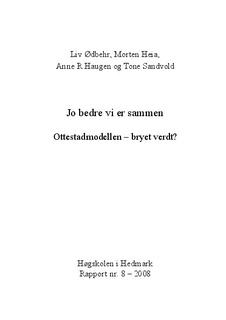| dc.contributor.author | Ødbehr, Liv Skomakerstuen | |
| dc.contributor.author | Heia, Morten | |
| dc.contributor.author | Haugen, Anne R. | |
| dc.contributor.author | Sandvold, Tone | |
| dc.date.accessioned | 2008-08-05T13:24:59Z | |
| dc.date.issued | 2008 | |
| dc.identifier.isbn | 978-82-7671-683-2 | |
| dc.identifier.issn | 1501-8563 | |
| dc.identifier.uri | http://hdl.handle.net/11250/133790 | |
| dc.description.abstract | Norsk: I 2005 ble det tatt i bruk en modell for planlagte samtaler med
pårørende ved Ottestad sykehjem. I undersøkelsen evalueres modellens kvalitet
i forhold til tre faser: innledningsfasen, samarbeidsfasen og oppfølgingsfasen.
Undersøkelsen avdekker sterke og svake sider spesielt i anvendelsen av modellen,
samt flere områder som blir gjenstand for videre kvalitetsutvikling.
Hensikten med undersøkelsen er å evaluere Ottestadmodellens tre faser for å
kunne utvikle den videre, slik at den kan styrke pasientenes mulighet for brukermedvirkning.
Undersøkelsen er både kvantitativ og kvalitativ i sin karakter. Det er blitt benyttet spørreskjema i datainnsamlingen rettet mot to ulike grupper av informanter, samt 10 påfølgende dybdeintervju. Informantgruppene er pårørende til pasienter på sykehjem med en demens- diagnose som har deltatt i en eller flere planlagte pårørendesamtaler, samt personalet som har gjennomgått minst en planlagt samtale
med pårørende. Spørreskjema er behandlet med dataprogrammet SPSS. Intervjuene er blitt analysert i henhold til Burnard’s (1991) innholdsanalyse.
Behovet for informasjon hos pårørende blir i vesentlig grad dekket ved hjelp av de planlagte samtalene. Både personalet og pårørende oppfatter modellen som
veiledende og støttende. I evalueringen av samarbeidsfasen avdekkes en del
utfordringer knyttet til tilsynslegeordningen, pasientenes behov for aktivitet, organiseringen av differensierte sykehjemsplasser i størst grad. Begge grupper
betrakter samarbeidet som godt, og at modellen gir muligheter for brukermedvirkning, men at det må arbeides mer med organiseringen av pleien og omsorgen
slik at den styrkes. Oppfølgingsfasen ivaretas på en tilfredsstillende måte i henhold til begge grupper av informanter, men varierer mye i prosess og innhold.
Modellen som redskap i pårørendearbeidet bedømmes av begge informantgruppene
som å være god. | en |
| dc.description.abstract | English: Ottestad nursing home has for a long time worked to purposefully
strengthen the involvement of relatives in the nursing and care of patients with dementia.
In 2005 a model was developed for planned conferences with the relatives
of patients. This investigation evaluates the quality of the model in 3 phases: the introductory
phase, the co-operation phase and the follow-up phase. The investigation
also reveals the strengths and weaknesses, especially in the use of the model, plus
several areas which are the object of further development.
Purpose: The purpose of the investigation is to evaluate the Ottestad model’s 3 phases so as to
develop them further such that it will strengthen the patient’s possibilities for more
involvement in the decisions about their care. This quality assurance is working towards
a goal to be a model for an alternative means for working with relatives of
patients.
Method: This investigation is both quantative and qualitive in its assessment. Questionnaires
have been used to gather data from 2 different target groups, along with 10 indepth
interviews. The first group are the relatives of nursing home patients who have
been diagnosed with dementia that have participated in one, or several conferences.
The second informant group is personnel who have taken part I at least one planned
conference with a patient’s relative. The questionnaire was processed using the
computer programme SPSS. The interviews have been analysed in conjunction with
Burnard (1991) content analysis.
Discoveries: The relatives need for information, is for a larger degree, covered by the planned
conferences. Both the personnel and the relatives experienced the model as guiding
and supportive. The evaluation of the co-operative phase reveals some challenges in
regard to the main doctor system, the patient’s need for activity, and the differentiation of nursing home places. Both groups view the co-operation as working well
and feel the model presents possibilities for patient involvement; though feel more
work is needed with the organisation of nursing and care so it can be improved. The
follow-up phase is delivered in a satisfactory way according to both groups of informants,
but varies a lot in process and content. The model for working with relatives
is judged by both groups as being good. | |
| dc.description.sponsorship | Ottestad sykehjem | en |
| dc.format.extent | 3128220 bytes | |
| dc.format.mimetype | application/pdf | |
| dc.language.iso | nor | en |
| dc.relation.ispartofseries | Rapport | en |
| dc.relation.ispartofseries | 08/2008 | en |
| dc.subject | pårørendearbeid | en |
| dc.subject | brukermedvirkning | en |
| dc.subject | demens | en |
| dc.subject | samarbeid | |
| dc.title | Jo bedre vi er sammen: Ottestadmodellen – bryet verdt? | en |
| dc.title.alternative | Together to the better: The Ottestad Model – worth the trouble? | en |
| dc.type | Research report | en |
| dc.subject.nsi | VDP::Medical disciplines: 700::Clinical medical disciplines: 750::Neurology: 752 | en |
